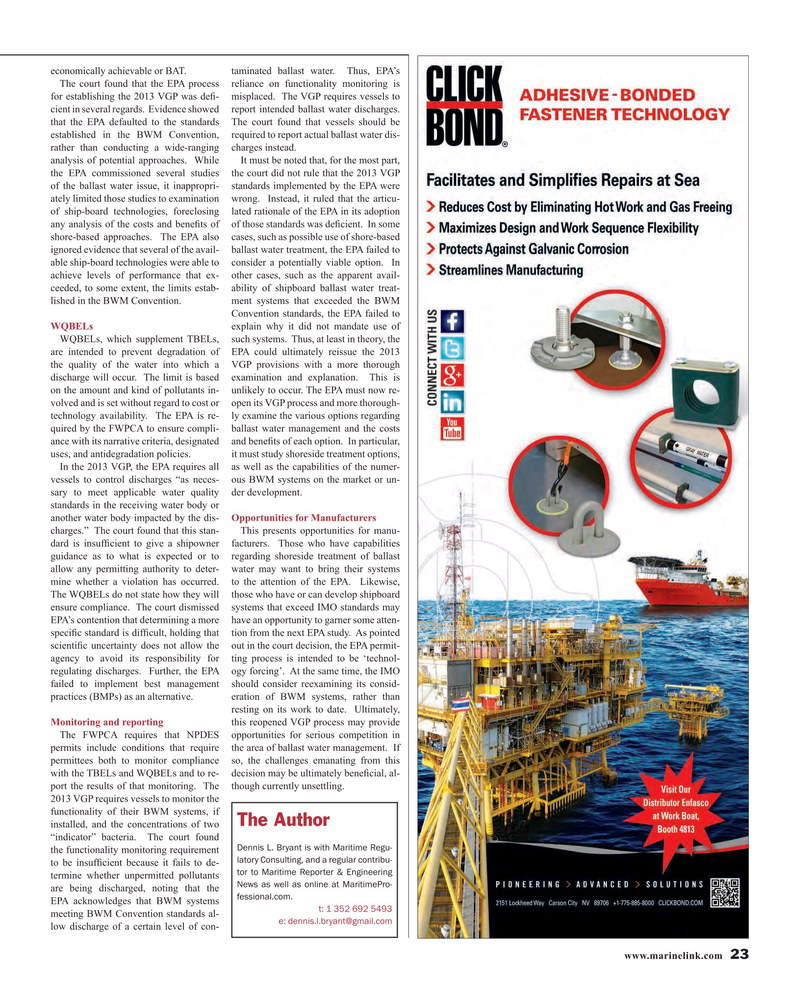
Page 23: of Maritime Reporter Magazine (November 2015)
Workboat Edition
Read this page in Pdf, Flash or Html5 edition of November 2015 Maritime Reporter Magazine
economically achievable or BAT. taminated ballast water. Thus, EPA’s
The court found that the EPA process reliance on functionality monitoring is for establishing the 2013 VGP was de? - misplaced. The VGP requires vessels to cient in several regards. Evidence showed report intended ballast water discharges. that the EPA defaulted to the standards The court found that vessels should be established in the BWM Convention, required to report actual ballast water dis- rather than conducting a wide-ranging charges instead.
analysis of potential approaches. While It must be noted that, for the most part, the EPA commissioned several studies the court did not rule that the 2013 VGP of the ballast water issue, it inappropri- standards implemented by the EPA were ately limited those studies to examination wrong. Instead, it ruled that the articu- of ship-board technologies, foreclosing lated rationale of the EPA in its adoption any analysis of the costs and bene? ts of of those standards was de? cient. In some shore-based approaches. The EPA also cases, such as possible use of shore-based ignored evidence that several of the avail- ballast water treatment, the EPA failed to able ship-board technologies were able to consider a potentially viable option. In achieve levels of performance that ex- other cases, such as the apparent avail- ceeded, to some extent, the limits estab- ability of shipboard ballast water treat- lished in the BWM Convention. ment systems that exceeded the BWM
Convention standards, the EPA failed to
WQBELs explain why it did not mandate use of
WQBELs, which supplement TBELs, such systems. Thus, at least in theory, the are intended to prevent degradation of EPA could ultimately reissue the 2013 the quality of the water into which a VGP provisions with a more thorough discharge will occur. The limit is based examination and explanation. This is on the amount and kind of pollutants in- unlikely to occur. The EPA must now re- volved and is set without regard to cost or open its VGP process and more thorough- technology availability. The EPA is re- ly examine the various options regarding quired by the FWPCA to ensure compli- ballast water management and the costs ance with its narrative criteria, designated and bene? ts of each option. In particular, uses, and antidegradation policies. it must study shoreside treatment options,
In the 2013 VGP, the EPA requires all as well as the capabilities of the numer- vessels to control discharges “as neces- ous BWM systems on the market or un- sary to meet applicable water quality der development. standards in the receiving water body or another water body impacted by the dis- Opportunities for Manufacturers charges.” The court found that this stan- This presents opportunities for manu- dard is insuf? cient to give a shipowner facturers. Those who have capabilities guidance as to what is expected or to regarding shoreside treatment of ballast allow any permitting authority to deter- water may want to bring their systems mine whether a violation has occurred. to the attention of the EPA. Likewise,
The WQBELs do not state how they will those who have or can develop shipboard ensure compliance. The court dismissed systems that exceed IMO standards may
EPA’s contention that determining a more have an opportunity to garner some atten- speci? c standard is dif? cult, holding that tion from the next EPA study. As pointed scienti? c uncertainty does not allow the out in the court decision, the EPA permit- agency to avoid its responsibility for ting process is intended to be ‘technol- regulating discharges. Further, the EPA ogy forcing’. At the same time, the IMO failed to implement best management should consider reexamining its consid- practices (BMPs) as an alternative. eration of BWM systems, rather than resting on its work to date. Ultimately,
Monitoring and reporting this reopened VGP process may provide
The FWPCA requires that NPDES opportunities for serious competition in permits include conditions that require the area of ballast water management. If permittees both to monitor compliance so, the challenges emanating from this with the TBELs and WQBELs and to re- decision may be ultimately bene? cial, al- port the results of that monitoring. The though currently unsettling.
2013 VGP requires vessels to monitor the functionality of their BWM systems, if
The Author installed, and the concentrations of two “indicator” bacteria. The court found
Dennis L. Bryant is with Maritime Regu- the functionality monitoring requirement latory Consulting, and a regular contribu- to be insuf? cient because it fails to de- tor to Maritime Reporter & Engineering termine whether unpermitted pollutants
News as well as online at MaritimePro- are being discharged, noting that the fessional.com.
EPA acknowledges that BWM systems t: 1 352 692 5493 meeting BWM Convention standards al- e: [email protected] low discharge of a certain level of con- www.marinelink.com 23
MR #11 (18-25).indd 23 10/30/2015 9:56:11 AM

 22
22

 24
24
